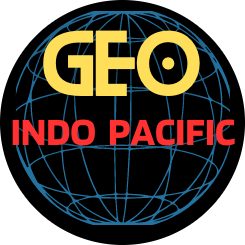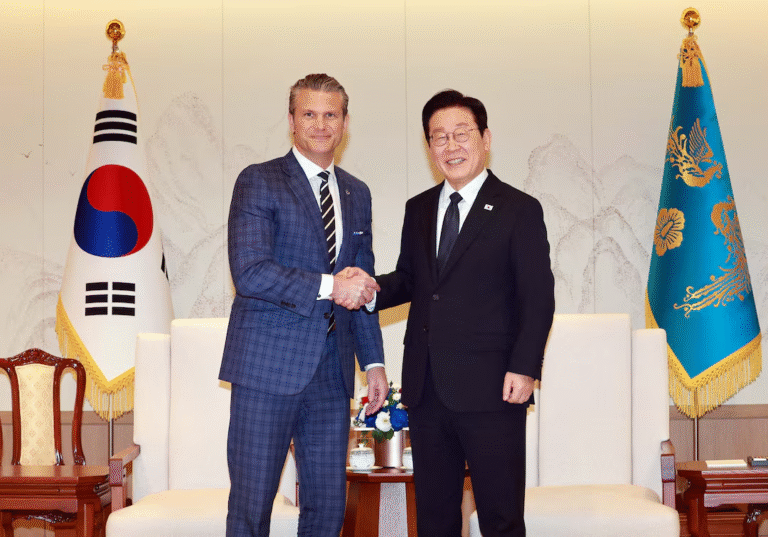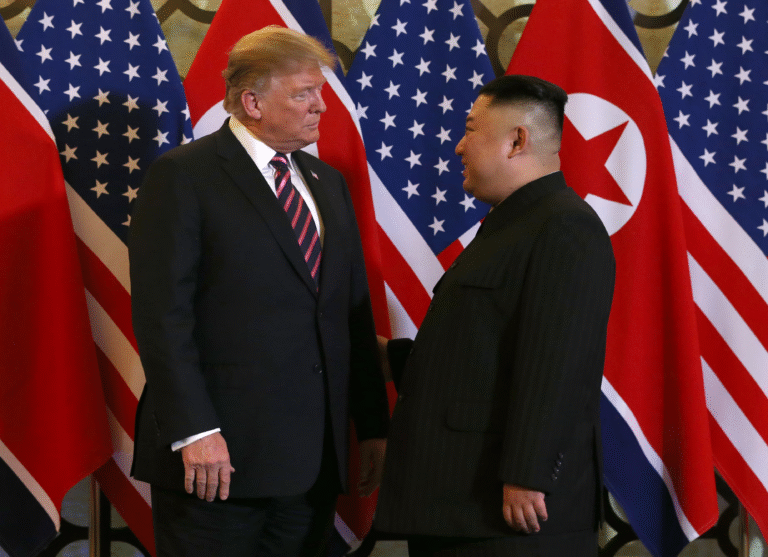
After his summit with South Korean President Lee Jae-myung on the sidelines of the 2025 APEC Summit in Gyeongju, South Korea, U.S. President Donald Trump announced that the United States has authorized South Korea to build nuclear-powered submarines (SSNs). The decision sent ripples across global strategic and non-proliferation circles.
In a social media post on October 29, Trump declared that the South Korea-U.S. alliance “is stronger than ever before and, based on that, I have given them approval to build a Nuclear Powered Submarine.”
In a separate post, he added, “South Korea will be building its Nuclear Powered Submarine in the Philadelphia Shipyards, right here in the good ol’ U.S.A.”
In these posts, Trump reframed one of the most sensitive defense-technology barriers in U.S. alliance policy – and did so in his typically public, unscripted manner.
Trump finally gave the U.S. seal of approval to a long-standing South Korean ambition: joining the elite club of nations operating SSNs. Washington had repeatedly resisted Seoul’s requests, however, citing non-proliferation constraints and the political sensitivity of transferring nuclear-propulsion technology.
Now, under Trump’s renewed “America First, Allies Invest” framework, the door appears open – but at what cost and consequence?
Strategic Logic: Strengthening Deterrence and Alliance Asymmetry
From Seoul’s perspective, SSNs represent a long-awaited strategic upgrade. Facing an increasingly sophisticated North Korean under-sea threat and a more assertive Chinese navy, South Korea has argued that nuclear propulsion is essential to ensure long-duration, stealthy patrols in the Indo-Pacific.
As Lee told Trump during their summit, “The diving capability of our conventional diesel submarines is limited, which restricts our ability to track North Korean or Chinese submarines.”
Unlike diesel-electric submarines, which must surface or snorkel to recharge batteries, SSNs can remain submerged for months – offering unmatched survivability and range. For Seoul, this translates into a credible deterrent, improved maritime domain awareness, and the ability to project power far beyond the Korean Peninsula.
For the Trump administration, there are two benefits to signing off on South Korean SSNs: burden-sharing and industrial reciprocity. Trump has consistently emphasized that allies must “pay their fair share” – and Seoul’s recent surge in U.S. investments, including Hanwha’s acquisition of the Philly Shipyard and a $20 billion defense co-production plan, fits that bill.
Industrial and Political Convergence: The “Philly Doctrine”
Trump’s approach to alliances has long merged security with commerce, and the South Korean SSN announcement reflects this logic. By linking the submarine initiative to Hanwha’s multibillion-dollar investment in the Philadelphia Shipyard, Trump turned a defense-technology partnership into both an alliance deliverable and a domestic political victory. Framed as part of his “Make American Shipbuilding Great Again” (MASGA) vision, the move signals that allied cooperation can also serve as a tool for U.S. industrial renewal.
For Washington, the strategy reinforces a transactional alliance model: allies that invest in the United States gain privileged access to advanced defense cooperation. The Philly Shipyard’s revival thus becomes both an industrial project and a political symbol of economic nationalism. Authorizing SSN development is framed as a reward for allied economic commitment and a step toward “re-industrializing” U.S. defense production on American soil.
For Seoul, participation in MAGSA offers entry into U.S. naval production networks and visibility in the U.S. defense market – and, now, the chance to realize the long-held dream of acquiring SSNs. However, it also ties the project’s fate to U.S. domestic politics.
This emerging “Philly Doctrine,” blending allied industrial participation with U.S. infrastructure revival, may produce innovative co-production frameworks and deeper supply chain integration. But it also risks politicizing technology transfer, turning strategic trust into a form of commercial leverage. For South Korea, the challenge will be to capture the industrial benefits of this partnership while avoiding entanglement in Washington’s political cycles and maintaining autonomy over its long-term naval modernization agenda.
Yet, this is an even more complex question at play: is the U.S. making a calculated alliance investment, or simply commodifying nuclear technology for political and industrial gain?
The Nonproliferation Dilemma
No issue is more controversial than the nuclear dimension. U.S. nuclear-propulsion technology, governed by the Atomic Energy Act and non-proliferation treaties, has only ever been shared with two nations – the United Kingdom and Australia through the AUKUS partnership. Both are Anglosphere allies with decades of nuclear-governance alignment and full-scope safeguards. South Korea, by contrast, is bound by a civil-nuclear cooperation agreement that strictly forbids enrichment and reprocessing without U.S. consent.
If Seoul’s SSNs require highly enriched uranium (HEU), the move would mark a seismic shift in global nonproliferation norms. Even if low-enriched uranium (LEU) reactors are adopted, questions will persist over who will supply and refuel the reactors, what safeguards will apply, and how transparency will be maintained vis-à-vis the International Atomic Energy Agency and neighboring states.
Arms control experts have already voiced concern that this “Korean AUKUS” could set a dangerous precedent, prompting North Korea to justify its own under-sea nuclear projects (and possibly incentivizing China and Russia to provide technological backing). The result could erode the moral authority of the global nonproliferation regime. For Washington, once the chief guardian of those norms, this marks an unmistakable policy departure.
The Regional Fallout
Beijing is likely to interpret the announcement as part of a broader U.S. strategy to contain China through an expanded under-sea alliance network. Even before the SSN decision, Chinese state media already accused the South Korea-U.S. alliance of “nuclear militarization in Northeast Asia,” blaming Washington for destabilizing the region under the guise of alliance cooperation. In response, China could increase submarine patrols and anti-submarine operations in the Yellow and East China Seas and deepen coordination with Russia in under-sea surveillance and joint naval exercises.
For Pyongyang, the move provides propaganda and strategic justification. The regime will portray Trump’s approval as proof of U.S. “nuclear double standards,” using it to legitimize its own submarine-launched ballistic missile (SLBM) tests and potential nuclear-propulsion ambitions. This dynamic risks fueling a regional arms race in the under-sea domain, eroding crisis stability and increasing the chance of miscalculation in already contested waters.
Tokyo, though supportive of stronger allied deterrence, faces an uncomfortable comparison. South Korea’s future SSNs could outshine Japan’s conventionally powered fleet, reigniting debates over Japan’s non-nuclear principles and the pursuit of deeper U.S. naval technology cooperation.
Meanwhile, Canberra may worry that the Korean case weakens AUKUS exclusivity after years of negotiation and political investment. Although Australia might welcome Seoul’s enhanced deterrence role, it could also see the precedent as complicating alliance cohesion and inviting Chinese countermeasures.
Trump’s declaration will thus reverberate across the Indo-Pacific. It strengthens deterrence among allies but simultaneously normalizes nuclear propulsion as a new standard for advanced navies – a shift that could blur the line between alliance modernization and strategic overreach.
Feasibility and Governance Challenges
Even with political approval from the White House, realizing an SSN program remains a formidable challenge for South Korea, as it is for Australia. Building nuclear-powered submarines demands not only advanced technology but also decades of reactor-design experience, a mature nuclear-safety culture, and a specialized industrial base capable of handling radioactive materials safely.
Neither Hanwha nor Hyundai Heavy Industries currently has experience in compact naval reactors or radiological certification, and the United States is unlikely to share its most sensitive reactor or fuel-handling technologies. As a result, Seoul will need years of indigenous research and rigorous testing before achieving a viable propulsion system, supported by the gradual establishment of a maritime nuclear governance framework..
To manage these risks, South Korea must strengthen institutional oversight involving the Atomic Energy Safety Commission, the Defense Acquisition Program Administration, and the National Assembly, ensuring that safety, budgetary discipline, and transparency are upheld.
Equally vital is human resource development. A nuclear submarine force will require specially trained engineers, reactor operators, and naval personnel – expertise that cannot be imported overnight.
The program’s timeline could therefore extend well into the 2030s, and costs are likely to exceed early projections. A single SSN could cost between $5 and $8 billion, with substantial long-term maintenance and training expenses. The AUKUS deal is estimated to cost Australia over $360 billion over the next 30 years.
Without strict governance and continuity across administrations, the SSN program risks drifting into political symbolism rather than becoming a real capability. Sustained oversight, investment in nuclear education, and adherence to international safety standards will determine whether this ambition becomes a credible capability or a costly distraction.
Implications for the South Korea-U.S. Alliance
This development represents both a deepening of alliance interdependence and the potential for renewed strategic friction. On one hand, it marks a more mature phase of the partnership in which South Korea contributes advanced maritime capabilities rather than relying solely on U.S. protection. The acquisition of SSN technology enables Seoul to operate on par with U.S. forces in the Indo-Pacific, reinforcing deterrence against China and North Korea while advancing Washington’s long-standing goal of allied burden-sharing.
Industrial integration is another major outcome. Through expanded co-production and MRO (maintenance, repair, and overhaul) cooperation, South Korea’s shipbuilding excellence complements the U.S. defense industrial base, which has faced capacity shortages. Initiatives like the Philadelphia Shipyard partnership illustrate how allied investment can simultaneously support U.S. infrastructure revival and strengthen Seoul’s foothold in the global defense supply chain. This evolving model could pave the way for a new era of industrial interdependence – one where technological innovation and production efficiency are jointly leveraged to sustain alliance power projection.
However, the decision also highlights enduring asymmetry in alliance management. The unilateral nature of Washington’s announcement reinforces perceptions that Seoul remains reactive to U.S. policy choices rather than shaping them. If mismanaged, this imbalance could revive tensions reminiscent of past burden-sharing and OPCON debates. To avoid this, South Korea must institutionalize co-ownership through a formalized governance mechanism – ensuring joint oversight on safety, reactor management, and operational doctrine from the earliest stages.
Ultimately, the SSN collaboration will test whether the alliance can evolve into a co-equal partnership built on shared technological and strategic trust. Managed prudently, it will enhance deterrence and demonstrate that the South Korea–U.S. alliance is capable of strategic innovation. Mishandled, however, it could expose the limits of Seoul’s autonomy and reaffirm that the most advanced forms of cooperation still hinge on Washington’s political discretion.
A Broader Indo-Pacific Reconfiguration
Beyond the Korean Peninsula, Trump’s announcement marks not merely a bilateral breakthrough but a reconfiguration of the Indo-Pacific’s maritime architecture. By extending nuclear propulsion cooperation to South Korea, Washington effectively expands the logic of AUKUS into Northeast Asia – constructing an informal “AUKUS-plus” network that links Australia, South Korea, and potentially Japan as regional pillars of U.S. under-sea power. This reflects a doctrine of distributed deterrence, in which the United States empowers capable allies with selective access to nuclear-related technologies while preserving overall strategic primacy.
The strategy strengthens deterrence through redundancy: multiple allied navies now contribute to maritime surveillance and strike capacity against China’s expanding fleet, easing the operational burden on the U.S. Navy. It also deepens defense-industrial integration, binding allied shipbuilding and MRO capacity to the U.S. supply chain and standardizing under-sea interoperability.
However, this distributed model comes with risks. The more Washington diffuses nuclear propulsion technology, the more it blurs long-standing nonproliferation norms, eroding its moral authority to restrain others from pursuing similar capabilities. Analysts warn that a “Korean AUKUS” could normalize nuclear propulsion as the benchmark for advanced navies, potentially encouraging other non-nuclear states to seek comparable systems.
Ultimately, the expansion of nuclear-propulsion cooperation could reshape alliance architecture for decades. It could mark a genuine strategic breakthrough – enabling South Korea to assume greater maritime responsibility, strengthen allied deterrence, and revitalize U.S. industrial capacity. But it could also herald a new era of nuclear exceptionalism, where sensitive technologies become tools of transactional diplomacy. Without transparent governance, clear nonproliferation safeguards, and a joint South Korea-U.S. implementation framework, the risks could outweigh the gains.





